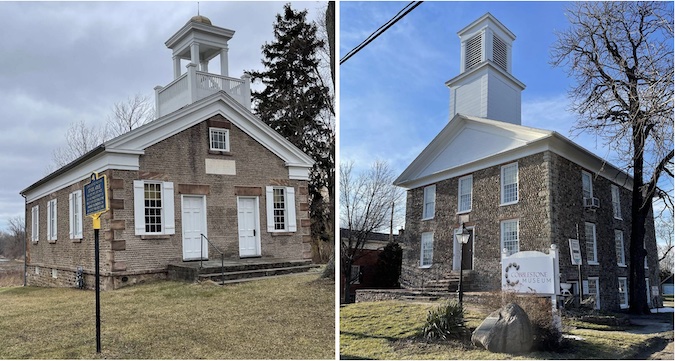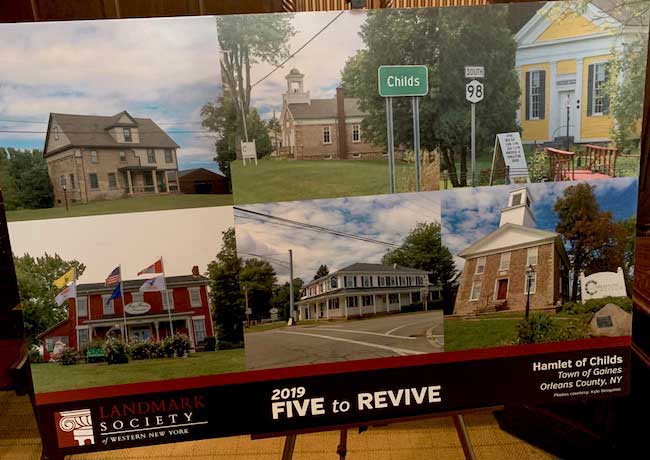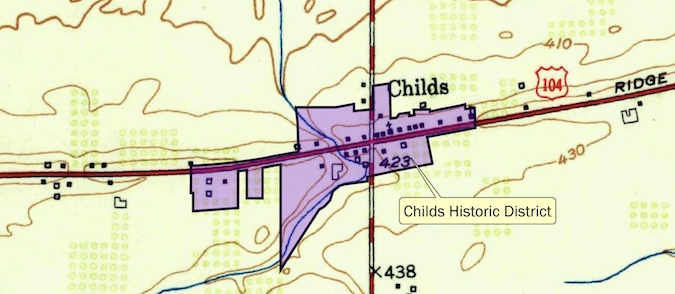29 buildings in Childs hamlet nominated by governor for National Register
Cobblestone Museum director says designation opens up grant possibilities and benefits property owners with tax credits

Photos courtesy of Landmark Society of WNY: The cobblestone schoolhouse from 1849, left, and Cobblestone Universalist Church from 1834 are among 29 contributing buildings in the historic district in the Childs Hamlet.
CHILDS – The Childs hamlet has been nominated by Gov. Kathy Hochul to be included on the state and national registers of historic places.
The Cobblestone Museum has been working with the Landmark Society of WNY on an application for the historic designation for 19 contributing primary buildings, 10 contributing secondary structures, one contributing object as well as 12 non-contributing secondary structures and two non-contributing primary buildings. The district is at the Ridge Road and Route 98 intersection and also extends along Ridge Road that reflect the rural and commercial character of the district.
Three of buildings – the cobblestone church, cobblestone schoolhouse and the Ward House – were declared a National Historic Landmark in 1993 by the U.S. Department of the Interior. The historic Childs hamlet expands the number of buildings to be recognized.
“Architectural styles seen in the nominated district reflect its long history with examples of Federal, Greek Revival, Colonial Revival, and one designed in the Craftsman style,” according to the nomination.
A National Register designation opens up grant possibilities and benefits homeowners with tax credits, said Dog Farley, the Cobblestone Museum director.
Once the designation is finalized, Farley said the museum plans to hold a community workshop to look at streetscape improvements in the hamlet.

Photo by Tom Rivers: The Landmark Society of Western New York in October 2019 unveiled its annual list of “Five to Revive,” which included the hamlet of Childs in the Town of Gaines, Orleans County. The district is home to several cobblestone buildings, Tillman’s Village Inn and other historic structures. That designation launched the effort to get the Childs hamlet recognized as a historic district.
He thanked the Landmark Society for its assistance in trying to elevate the status of the hamlet. The Landmark Society in October 2019 named the Childs hamlet to its annual list of “Five to Revive,” an annual list of historically significant sites that are need of protection and financial resources.
“The future economic potential of Childs lies in its unique historic character,” The Landmark Society stated in October 2019. “Modern planning and zoning practices that encourage sensitive new construction, along with the addition of pedestrian-oriented infrastructure and design, could help guide the hamlet’s growth and enhance its economic development.”
The Childs district includes a historic schoolhouse, the First Universalist Church, residences, a former village inn and stagecoach stop, a former blacksmith shop, and mid-nineteenth to early-twentieth century agricultural buildings such as barns.
The museum has also relocated several mid-to-late 19th century buildings. Those buildings are non-contributing to the nominated district because they were moved to the complex outside the nominated period of significance, beginning in 1977. The buildings should therefore be reevaluated as a museum unit when their date of relocation collectively achieves 50 years of age from when the last building was moved to the campus, the Landmark Society stated in the nomination packet.

Map from Landmark Society of WNY: The district is at the Ridge Road and Route 98 intersection and also extends along Ridge Road.
The description from the governor’s office about the Childs hamlet includes:
“Childs Historic District, Orleans County – The Childs Historic District represents the critical relationship between rural and commercial that characterized the nineteenth century in New York. The hamlet of Childs developed at the intersection of two new state routes during the 1800s which later developed into major thoroughfares.
“The community’s proximity to the Erie Canal catapulted it onto the global stage in the 1820s, as Orleans County became the national center of wheat production as a result of being able to cheaply and efficiently ship wheat eastward. Suddenly, rural subsistence farmers were plugged into massive markets and quickly became cash crop farmers.
“This resulting economic stability led to an increase in building and infrastructure, and locals were able to construct buildings that reflected their wealth and prosperity. The architectural resources in this historic district collectively represent the hamlet’s commercial development due to its prominent location from 1820 until 1960.
“The district includes Federal, Greek Revival, Colonial Revival, and even one Craftsman-style building. The several Greek Revival structures built using cobblestones present a unique regional building material and method of construction.
“Taken together, these buildings retain their character-defining features and integrity of design, materials, workmanship, and feeling while their proximity to roadways evoke a mid-nineteenth to early twentieth-century community feel. They also highlight efforts to preserve the hamlet’s architectural heritage which dates back to the 1960 founding of the Cobblestone Society.”

The brick house from the 1820s is at the southeast corner of routes 98 and 104. The site will become the Thompson-Kast Visitor Center for the museum.
The Childs hamlet is among 37 nominations for State and National Registers of Historic Places announced by Gov. Kathy Hochul. She said the sites have been recommended by the New York State Board for Historic Preservation.
“These nominations reflect generations of community building, planning, and activities that give us a glimpse into our collective past as New Yorkers,” Hochul said in a statement. “Identifying these resources and adding them to our historic registers expands our ongoing understanding of our shared history and are important reminders of the innovation, passion, and lived experiences of New Yorkers who came before us.”
New York State Office of Parks, Recreation and Historic Preservation Commissioner Erik Kulleseid will now review the recommendations for approval. That list will then go to the National Park Service for a review. Once approved, they are entered on the National Register.







































































